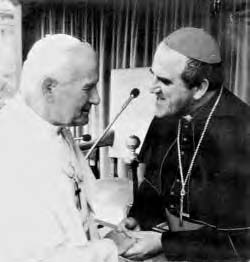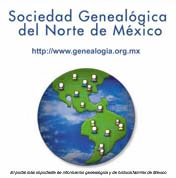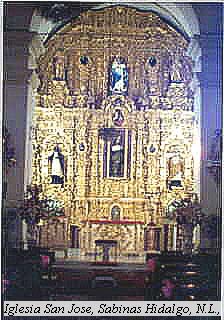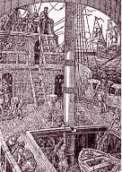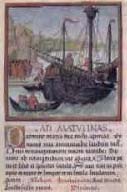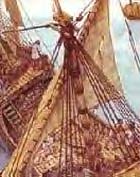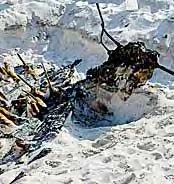Cuba
Patriots of the American Revolution, Part 3, (K-M)
The explanation of Spanish participation in the Revolutionary War, and the
role of Cuban soldiers, sailors, and citizens are explained in earlier
issues of Somos Primos. Descendants of those who served are eligible to
join the Sons of the American Revolution (SAR). Anyone interested may
contact Granville W. Hough, at gwhough@oakapple.net
for assistance.
K . . .
*Andrés Kiss (Cataluna - ). Soldier and Distinguished Cpl, 1771-1783,
served at Gibraltar, Pensacola, and Cadiz, Lt, San Carlos de Perote, Regt
Corona of New Spain, 1800, single, Legajo 7277:III:37.
L . . .
*Thomas Labaia. M:349, Capt, ship La Union in May 1782 invasion
of Nassau.
Pedro Lachi. Sgt, 1791, Inf of Cuba, Legajo 7261:XXVI:57.
*Lacoute & Company. Neeser:6, 132, Conyngham:483, merchants at Cadiz,
Spain, who traded with Americans.
*??? LaForre. Mob:719, furnished boat for Regt of Spain to move troops
from Mobile to Pensacola, 1781.
Domingo Antonio de Laji. Sgt, Inf of Havana, 1792. Legaho 7261:XI:118.
*M. Lalone/LaLonne. MP:153, 186, Commandante of the Serpent. Mir:175, off
Pensacola in 1781.
Domingo Ramón de Lamadriz. Cadet, Inf of Havana, 1799. Legajo
7264:XXVI:94.
*Francisco Javier de Lamadrid/Lamadriz (1748 Havana - ), entered service
in 1764, Adjutant Major in 1782, Capt, Havana Regt, 1786, married. Sgt
Major, Inf of Havana, 1799, Legajo 7264:XVI:3 and 61.
Nicolás de Lamadriz. Cadet, Inf of Havana, 1799. Legajo 7264:XVI:119.
Pedro José Lamadriz. Cadet, Inf of Cuba, 1799. Legajo 7264:XVII:105.
*Joaquín de Landa (1747 Florida - ), in Expedition to Providence, 1781,
Lt, Havana Regt, 1786, married. A3:XI:61, mentioned c 1781. Capt, 1792,
Inf of Havana, Legajo 7261:XI:97.
*Juan de Landa. Capt of Grenadiers, grad Lt Col, 1765, Inf of Havana,
Legajo 7259:XVI:2, this may be
*??? De Landecho. Chevalier:355, Spanish navy captain of the Septentrion,
60 guns, in combat 20 Oct 1782.
*??? Landiburu. Beerman:136, 144, Mob:667, Capt, packetboat, Santa
Cathalina, Pensacola, 1781.
Manuel Langele. Cadet, Squadron, Dragoons of America, 1799. Legajo
7264:XII:88.
*Joaquin de Langelet. Adjutant, 1799, Mil Cav of Havana, Legajo
7264:XII:88.
Antonio Llamas. Cadet, Inf of Havana, 1799. Legajo 7264:XVI:107.
*Joseph de Llano. Klotz:34, Capt of the Santander captured and condemned
in MA in 1779.
Francisco Lleonard. Cadet, Inf of Cuba, 1799. Legajo 7264:XVII:111.
Tomás Llorente. Lt, Inf of Cuba, 1799. Legajo 7264:XVII:35.
*Manuel de Lanzos. CubaP:1224 and many others, HamV:333, 336, Governor of
Mobile, 1791.
*J. B. LaPuente. M:349, Capt brigantine La Maria in May 1782 invasion of
Nassau.
*Francisco María de Lara (1749 - ). Entered service 1766, 1st Sgt, Havana
Cav, 1787 and 1799. Legajo 7264:XII:57.
**Josef de Lara. M:113:App G, Ensign 2d Bn of Regt of Spain, rec. for
promotion after Mobile, 1780.
*Manuel de Lara. MP:95, tax collector in the Trinidad area of Cuba, 1781.
*Antonio Lareo. Capt, 1799, Mil Dragones de Matanzas, Legajo 7264:VII:8.
*??? Larizosa. MP:164, Naval Captain in Pensacola expedition commanding
the trenches on 1 May 1781.
*Mariano LaRocque. Ch1:Attachment, Lt, Pensacola staff, 1781. Tanner:28,
went to East Florida in early 1784 as chief engineer.
Miguel Larrea. Sgt, Inf of Cuba, 1799. Legajo 7264:XVII:78.
Luís de Las Casas. K:126, Governor of Cuba, 1790.
*Rafael Laso (1748 - ), entered service, 1766, Adjutant Garzon, Morenos,
1787, Lt, 1799, Plana Mayor de Morenos, Havana, Legajo 7264:VIII:5.
José Francisco Latorre. Sgt, Militia of Cuatro Villas, 1792. Legajo
7261:IV:37.
José María de Latorre. SubLt, Inf of Havana, 1799. Legajo 7264:XVI:64.
*Marciana de LaTorre. Ch2:15, at Pensacola, 1781.
Carlos Laurent. Sgt, Inf of Cuba, 1799. Legajo 7264:XVII:81.
*José Joaquín de Layas (1745 - ), entered service, 1763, Capt, Havana
Inf, Blancos, 1787.
Pablo de Leiva. Cadet, Comp. Independent, under Cuba, 1791. Legajo
7261:XXVIII:16.
*Pedro Martin de Leiba of Havana. Chávez:225, in 1781 lender of money to
the French navy.
*Ignacio Leite Vidal. Lt, 1792, Inf of Havana, Legajo 7261:XI:105.
*Gregorio Lemes. A3:XIII:10, 1st Cpl, c 1783.
Agustín de León. Sgt, Inf Militia of Havana, 1799. Legajo 7264:XIII:103.
*Francisco de León. Lt, Grad Capt, Staff for Pardos of Cuba y Bayamo,
1789. Legajo 7260:XVII:2.
Francisco Miguel de Leon. Cadet, Inf Militia of Cuba y Bayamo, 1799.
Legajo 7264:XI:57.
Joaquin León. Lt, Staff, Bn of Pardos of Havana, 1799. Legajo 7264:V:7.
José Joaquin de León. Cadet, Inf Militia of Cuba y Bayamo, 1799. Legajo
7264:XI:53.
*Miguel de León. Woods:235, Sgt Regt of Havana, sponsored bap, 1779, New
Orleans.
*Tw. Lerama. M:349, Capt, snow El Camiero, in May 1782 invasion of Nassau.
*Francisco Lezame. Mob:667, Capt, packetboat, Nuestra Señora del Carmen,
Pensacola, 1781.
*Pedro Lezaun/Lesaun. A3:XI:30, Ensign, c 1781.
*Federico Lilis (1723 Tortusa - ), Capt Comandante in 1780, Comandante,
Grad Lt Col, Havana Inf, 1788, married. Capt, 1792, Comp Inf, Cataluña in
Havana, Legajo 7261:IX:1. Mob:296, Capt, Volunteers of Cataluña, at
Mobile, 1780.
Andrés de Lima. SubLt, Mil Dragones de Matanzas, Legajo 7262:III:22.
*Nicolás de Limia (1737 - ), entered service 1753, Lt Blancos of Havana,
1787. Lt, grad Capt, 1799, Mil Inf Havana, Legajo 7264:XIII:20.
*Isidro de Limonta. Brigadier, 1800, Plana Mayor de Santiago, Cuba, Legajo
7264:I:1.
*Nicolas de Limonta (1761 Cuba - ), Cadet in 1779, SubLt of Bandera,
Havana Regt, 1786, single. Adjutant, 1799, Inf of Havana, Legajo
7264:XVI:33.
*Rafael de Limonta (1719 Cuba - ), Capt in 1779 and 1786, Havana Regt,
married. Capt, 1792, Inf of Havana, Legajo 7261:XI:91.
Joaquín Liriano. Sgt, 1791, Mil de Cuatro Villas, Legajo 7261:XV:40.
*José Lleonard (1769 Bayamo - ), Cadet in 1781 and 1786, Havana Regt,
single.
*Juan Lleonard/Gemmir y Lleonart (1731 Havana - ), Lt Col in 1777, in 1786
Plana Mayor, Havana Regt, married. K:126, Havana, Lt Col, 2d Bn, Cuban Inf
Vol, 1788. Legajo 7264:XVII:1, Col, Inf of Cuba, 1799.
*Juan Lhenard (1765 - ), entered service, 1782, Cadet, Inf Vets of Havana,
1788.
*Juan Bautista Lleonard (1767 Bayama - ), Cadet, 1780 and 1786, Havana
Regt, single. Lt, 1799, Inf of Cuba, Legajo 7264:XVII:36.
Tomás Llorente. Lt, 1799, Inf of Cuba, Legajo 7264:XVII:35.
Francisco Loisel (1740 San Cristóval de la Laguna - ), service record
begins as Capt Agregado in 1785 which rank he held in 1786 in Havana Regt.
Legajo 7264:XVII:10, Capt, Cuban Inf, 1799. It is probable that he had
prior service.
Joaquin Loisel y Fromesta. Cadet, Inf of Cuba, 1799. Legajo 7264:XVII:117.
*Alvaro López. A2:X:25A, soldier, c 1780.
*Antonio López Gavilan (1739 - ). Entered service 1776, Surgeon, Inf
Blancos of Havana, 1787.
*Antonio López de Toledo. Capt, 1792, Inf of Havana, Legajo 7261:XI:7.
Antonio López de Toledo. Lt, Inf of Havana, 1799, Legajo 7264:XVI:26.
*Diego López (1752 - ), entered service 1770, Adjutant Garzon, Pardos,
1787. Legaho 7261:XXVI:54.
*Felipe López Carrizosa. Thonhoff:38, Haarmann:129, Naval Captain of the
Ship, Fourth Brigade Commander at Pensacola. MP:155. C&C:116,
commanded the fourth brigade of five at Pensacola, 1781.
*Francisco López (1730 - ), entered service 1758, 1st Sgt of 6th Comp,
Blancos, Cuba y Bayamo, 1787.
*Francisco López de Gamarra (1755 Havana - ), Lt in 1775, Lt, 4th Comp,
Dragones de America, 1786, married, Legajo 7259:XIII:11.
Francisco Javier López. SubLt, Militia of Cuatro Villas, 1799. Legajo
7264:X:24.
Gabriel López de Castro. SubLt, Cav Militia of Havana, 1799. Legajo
7264:XII:46.
*Ignacio López (1733 Craxell - ), in Expedition of Mobile and taking of
Pensacola, SubLt, Havana Inf, 1788, widowed. Lt, 1799, Comp Inf de Cataluña,
Havana, Legajo 7264:VI:5.
*José López Ganuza. Capt, 1799, Inf of Cuba, Legajo 7264:XVII:25.
José Justo López de Toledo, Cadet, Inf of Havana, 1792. Legajo
7261:XI:68.
*José Manuel López of Havana. Chávez:225, in 1781 lender of money to
the French navy.
*Juan López (1760 Bisbal - ), at Mobile and Pensacola, SubLt, Havana Inf,
1788, single. Legajo 7264:VI:9, SubLt, 1799, Inf of Cataluña in Havana.
Juan Crisóstomo López de Toledo. Cadet, Inf of Havana, 1792. Legajo
7261:XI:78.
Juan José López Ramos. Sgt, Militia of Cuatro Villas, 1799. Legajo
7264:X:38.
Juan Manuel López Perez. Cadet, Inf of Cuba, 1799. Legajo 7264:XVII:113.
Justo López. Sgt, Inf of Cuba, 1799. Legajo 7264:XVII:82.
Manuel López de Queralta. Cadet, Inf of Cuba, 1797. Legajo 7263:XV:94.
Mariano López Villavicencio. Distinguished Soldier, Cav Militia of
Havana, 1793. Legajo 7262:XX:112.
Nicolás López. SubLt, 1789, Mil de las Cuatro Villas, Legajo
7260:XIII:24.
*Pedro López. M:351, Capt sloop La Sacristana in May 1782 invasion of
Nassau.
*Prudencio Lorenzo (1740 - ), entered service 1763, SubLt, Blancos, Havana
Inf, 1787.
*??? Losa. M:350, Capt, brig galley La Regna de los Angeles in May 1782
invasion of Nassau.
Angel Losada. Sgt, Inf of Cuba, 1792. Legajo 7261:XII:50.
Felipe Losada. SubLt, Mil Inf, Cuba & Bayamo, Legajo 7262:VII:25.
Gabriel José Loyola. Cadet, Militia of Cuatro Villas, 1793. Legajo
7262:XVII:54.
Francisco Loysel (1740 - ), served from June, 1785, Capt Inf Vets of
Havana, 1788. There may have been prior service, otherwise he bought his
commission.
*Phelipe Lozada (1739 - ), entered service 1764, SubLt, 1st Comp, Blancos,
Cuba y Bayamo, 1787.
*Juan Lozano (1758 - ), entered service 1776, Adjutant Garzon, Morenos,
1787. Lt, 1797, Mil Inf of Havana, Legajo 7263:XI:22.
*Eugenio Lucas (1754 Castilla la Vieja - ). Soldier and Cpl, 1776-1788, in
Gibraltar blockade and in American operations, 1781-82, SubLt, Inf Puebla,
1800, Havana, Legajo 7277:VI:49.
Andrés de Luna. Ch1:12, Lt, Prince's Regt of Inf, to LA Picket from
Havana, Aug 1779.
Antonio de Luna. Sgt, Militia of Cuatro Villas, 1799. Legajo 7264:X:47.
*Antonio de Luque (1727 - ), entered service 1745, Lt of Grenadiers in
Blancos, Cuba y Bayamo. Lt, grad Capt, 1799, Mil Inf de Cuba y Bayamo,
Legajo 7264:XI:38.
*Antonio de la Luz (1749 - ), entered service 1765, Lt and Adjutant Major,
Inf Vets of Havana, 1788. Lt Col, 1799, Mil Inf of Havana, Legasjo
7264:XIII:4.
*Ignacio de la Luz. Capt, grad Lt Col, Inf of Cuba, Legajo 7264:XVII:9.
Román de la Luz. SubLt, Cav Militia of Havana, 1799l Legajo 7264:XII:30.
M . . .
*Pedro Macedo (1750 - ), entered service in 1766, 1st Sgt, Inf Blancos of
Havana, 1787. Legajo 7261:XIX:31.
Antonio Macias. SubLt, 1794, Mil Cav, Havana, Legajo 7262:VIII:41.
Francisco Macias. Lt, 1799, Mil Inf of Havana, Legajo 7264:XIII:23.
*Diego Madrid (1760 Extramadura - ). Soldier and Cpl, 1776-87; in
Gibraltar blockade and in American operations, went to Lima after the
peace, SubLt, Inf Puebla, 1800, Havana, Legajo 7277:VI:52.
Antonio José Madrigal. SubLt of Bandera, Militia of Cuatro Villas, 1799.
Legajo 7264:X:71.
*Félix Madrigal. Capt, 1792, Mil de las Cuatro Villas, Legajo 7261:IV:6.
Antonio Madruga. Lt, 1799, Mil Dragones de Matanzas, Legajo 7264:VII:27.
José Maestrati. LSgt, Inf Militia of Havana, 1797. Legajo 7264:IX:43.
*José Magarola. Mob:18, Capt, frigate, San Ignacio de Loyola, for
Pensacola, 1781.
Antonio Magno. Sgt, Comp Inf from Cataluña in Havana, 1794. Legajo
7262:XI:23.
*Bartolomé Mañán. Mob:277, owner, bercha La Mobileña, use by troops at
Mobile, 1780.
Antonio María Mancebo. SubLt, Inf of Havana, 1799. Legajo 7264:XVI:65.
Bernardo Mancebo. Cadet, Inf of Havana, 1799. Legajo 7264:XVI:102.
Estanislaus Mancebo. Cadet, Inf of Havana, 1799. Legajo 7264:XVI:125.
*Juan Mancebo (1757 Ciudad Cuba - ), at Mobile 7 Mar 1780, on 20 Mar 1781
on warship Gallardo with Grenadiers, Cadet, Havana Regt, 1786.SubLt, 1792,
Inf of Havana, Legajo 7261:XI:111.
Pedro Mancebo. Cadet, Inf of Havana, 1799. Legajo 7264:XVI:124.
*Santiago Mancebo (1748 Cuba - ), married by 1787. He was a Cadet in the
Cuban Militia prior to 1779, then Cadet, 1779, SubLt, Bandera, 1781, Vol
Blancos, Aragua. Poss SubLt of Grenadiers, 1799, Inf of Cuba y Bayamo,
Legajo 7264:XI:5.
Matías Mainar. Sgt, Staff, Bn of Pardos Militia of Cuba y Bayamo, 1799.
Legajo 7264:IX:7.
*José Mannrique. Lewis:34, 39, 47, 51, Brigadier General and Squadron
Commander returning from Nassau to Havana, 1782.
José Rafael Manressa. Distinguished Soldier, Cav Militia of Havana, 1793.
Legajo 7262:XX:105.
*Francisco Mantilla. Mob:546, soldier, Regt of Havana, wounded at the
Village, 1781.
*Josef Manzano Gonzales. Ch1:9, New Spain recruit for LA Regt, onNuestra
Señora del Carmen, Mar 1779.
*Tomás del Manzano. Mob:19, Lt of Militia, goleta La Pureza de María,
1780, at Mobile.
*Tomás Salas Manzano. A2:IX:7, 25, 46, Capt, c 1779, and A2:X:75, c 1780.
Miguel Francisco Manzo. Sgt, Inf Militia of Cuba y Bayamo, 1799. Legajo
7264:XI:46.
Manuel Mariño. Cadet, Militia of Cuba y Bayamo, 1799. Legajo 7264:XI:31.
*Josef Maristán. Mob:466, Capt, packetboat, Nuestra Señora del Rosario,
#16, at Pensacola, 1781.
Maximiliano Marñant. A3:XII:33, mentioned c 1782.
Miguel de Marquiz. A3:XII:33, mentioned, c 1782.
*J. D. Marrera/Merrera. M:349, Capt snow El Carmen in May 1782 invasion of
Nassau.
*Juan Ramon Marrero. Ch1:19, unm CI recruit who joined Havana Matanza
Dragoons, Aug 1779.
*Pedro Marrot. Capt, 1796, Inf of Cuba, Legajo 7263:XXIII:76.
Tadeo Marti. SubLt, Inf of Cuba, 1799. Legajo 7264:XVII:71.
Cándido Martin. Sgt, Cav Militia of Havana, 1799. Legajo 7264:XII:61.
*Fernando Martín de Zéspedes. Mob:148, 149, SubLt from Havana Regt, at
Mobile, 1780.
*Jan Martin. Appeals Case 95, crewman in 1782 on the Spanish San Antonio.
José Rafael Martin. Distinguished Soldier, Cav Militia of Havana, 1793.
Legajo 7262:XX:106.
*Alonzo Martínez. C&C;101, soldier, Regt of Havana, killed at the
(Mobile) Village in 1781.
Bernardino Martínez. Surgeon, 1795, Mil Inf, Cuba & Bayamo, Legajo
7262:VII:7.
Claudio Martínez de Pinillos. Porta-Estandarte, 1799, Mil Cav of Havana,
Legajo 7264:XII:55.
Diego Martínez. Sgt Cav Militia of Havana, 1799. Legajo 7264:XII:59.
Dionisio Martínez. Lt, 1799, Mil Dragones de Matanzas, Legajo
7264:VII:13.
*Feliz Martínez. Appeals Case 95, cook’s mate, on the Spanish San
Antonio, Nov 1782.
Francisco Martínez. Cadet Inf Militia of Havana, 1799. Legajo
7264:XIII:118.
Francisco Martínez. Adjutant, 1799, Plana Mayor del Bn Morenos,
Havana,Legajo 7264:VIII:7.
*José Martínez (1750 - ), entered service 1766, 2d Sgt, Inf Blancos of
Havana, 1787.
José Martínez. Cadet, Militia of Havana, 1799. Legajo 7264:XIII:119.
Juan Martínez Vallejo. Adjutant, 1799, Mil Cav of Havana, Legajo
7264:XII:16.
Juan José Martínez. Sgt, Cav Militia of Havana, 1797. Legajo 7263:X:60.
*Manuel Martínez. Legajo 7264, XVII:17, Capt, Cuban Inf Regt, 1799.
*Manuel Ulpiano Martínez (1744 la corde de Madrid - ), Distinguished
Soldier, 1776, Supernumerario and Cadet, Havana Regt. Legajo 7259:XII:120.
Ramón Martínez. A2:X:54, mentioned, c 1780.
*Vicente Martínez (1755 - ), entered service in 1773, 1st Sgt, Inf Vets
of Havana, 1788. SubLt, Inf of Havana, 1799, Legajo 7264:XVI:57.
*Isidro Mas. Capt, 1786, Comp Inf de Cataluña in Havana, Legajo
7259:XI:3.
José Mas. Cadet, Comp. Inf from Cataluña in Havana, 1799. Legajo
7264:VI:19.
*??? Masas. Mob:667, Capt, schooner La Concepción, at Pensacola, 1781.
*Antonio Masias (1748 - ), entered service in 1769, 2d Sgt, Havana Cav,
1787. Legajo 7264:XII:48.
*Francisco Masias (1758 - ), entered service, 1776, 1st Sgt, Inf Blancos,
Havana, 1787.
*José Masot. Capt, 1796, Arty of Havana, Legajo 7263:XXI:8.
*Antonio Matanza. Lt, 1793, Mil de las Cuatro Villas, Legajo 7262:XVII:11.
*Joaquín Matas y Alos. Capt, 1796, Corps Arty of Havana, Legajo
7263:XXI:1.
*Francisco Mathcos/Matheos. A3:XI:62, Cpl, c 1781.
Domingo Matienzo. Cadet, Inf of Havana, 1788. Legajo 7259:II:105. Also a
Cadet in 1791, Legajo 7261:XII:73.
José Matienzo. Cadet Inf of Havana, 1788. Legajo 7259:II:104. He may be
the Cadet in 1792 in Inf of Cuba, Legajo 7261:XII:61.
*Ramón Mauduit y Varela. Capt, 1799, Inf of Cuba, Legajo 7264:XVII:21.
*Matias Maynar (1762 - ), entered service in 1779, 1st Sgt, Inf Blancos,
Havana, 1787, Legajo ???.
Diego Mayoli. Lt, 1799, Inf of Cuba, Legajo 7264:XVII:47.
Pedro Mayordomo. Sgt, Inf of Cuba, 1797. Legajo 7263:XV:69.
*Luís de Medina (1754 Valencia - ), in Pensacola Expedition, 1780, SubLt,
Havana Inf, 1788, married. Lt, 1796, Inf of Cuba, Legajo 7263:XXIII:78.
*Rafael Medina of Havana. Chávez:225, in 1781 lender of money to the
French navy.
*Francisco Medrano. Capt, 1799, Mil Inf de Puerto Príncipe, Legajo
7264:XIV:9.
*Juan Melo (1755 - ), entered service 1773, Lt, Blancos of Havana, 1787.
Juan de Melo ( - 1799). FD5:154, he and wife Bibiana Villalona (died 1823,
Baní), had ch during war years.
Juan Mena. Surgeon, 1799, Plana Mayor Bn Pardos Mil de Cuba & Bayamo,
Legajo 7264:IX:11.
*José Mendez (1758 - ), entered service 1773, Lt in Havana Arty, 1788.
Capt, 1796, Corps Arty Havana, Legajo 7263:XXI:7.
*Leonardo Mendez (1753 - ), entered service 1778, 1st Sgt, Havana Cav,
1787. Lt, 1799, Mil Cav of Havana, Legajo 7264:XII:27.
Tomás Medina. Cadet, Inf of Cuba, 1797. Legajo 7263:XV:91.
Juan Medinilla. Sgt, Militia of Cuatro Villas, 1793. Legajo 7262:XVII:38.
*Antonio de Mendoza (1757 - ), entered service 1776, Lt, Havana Arty,
1788. Legajo 7263:XXII:10, Capt, Arty Corps of Havana, 1796.
*Joaquin Mendoza (1757 - ), entered service 1775, Sgt, 4th Comp, Dragoons
of America, 1788. Legajo 7264:XV:24.
*José Cayetano de Mendoza (1743 Island of Gomera - ), entered service in
1762, 1st Sgt of 8th Comp in Cuba y Bayamo Blancos. Lt, 1797, Mil Inf Cuba
& Bayamo, Legajo 7263:IX:37.
Gabriel Menocal. Cadet, Inf of Cuba, 1799. Legajo 7264:XVII:92.
Joaquin Menor. Cadet, Militia of Cuatro Villas, 1799. Legajo 7264:X:19.
*Sebastián Merancourt/Betancourt. A3:XI:13, 13, 15, c 1781.
Manuel Merino (1755 Madrid - ), entered service 1784, Lt in Blancos of
Havana, 1787, married. Lt, 1789, Mil Inf of Havana, Legajo 7260:IX:27.
There may have been prior service.
*Juan Bautista Mesa. A2:X:17, 1st Cpl, c 1780.
Tomás de Mesa. Sgt, Militia of Havana, 1792. Legajo 7261:VI:38.
Jorge Mesh. BR:541, German soldier in Cuban Inf, bur 1792, SJO.
*Francisco Mestre. A2:X:47, Capt, c 1780. Mob:277, Capt, packetboat Carmen
at Mobile in 1780.
*Simón Mexino. A3:XIII:18, 2d Cpl, c 1782.
*??? Meyreles. Mob:667, Capt, sloop El Rosario, Pensacola, 1781.
*José Luís Meyreles (1752 - ), entered service 1773, SubLt, grad Capt,
Blancos of Havana, 1787, married. K:185-186, 188, subLt in 1781, later
Capt, Cuban Vol Inf Regt. Legajo 7265:I:7.
*Pedro Mier. Lewis:93, 135, Official Mayor of the Cuban Intendancy, sent
to Nassau in 1783 by the Exchequer.
*Bernardo Miguel. Appeals Case 95, mariner in Nov 1782 on the Spanish San
Antonio.
*Joaquín Milot (1754 Alicante - ), entered service 1775, at Pensacola and
Mobile, Sgt, 4th Comp, Dragoons of America, 1786, single. Legajo
7260:VII:19, Sgt, Dragoons of America, 1789.
Jose Millan. Sgt, Inf Militia of Puerto Príncipe, 1799. Legajo
7264:XIV:36.
*Juan de Miralles y Trajan/Troyllón (1713 Petral, Valencia – 1780
Morristown, NJ). Abbey:61, footnote 17, and 64, 1779 Havana merchant.
Cummins:208, Spanish observer at Philadelphia, 1778-1780. James:253-254,
originated Spanish policy on Mississippi River. Beerman:294, wife was María
Josefa Eligio de la Puente.
Felipe Miranda. Legajo 7262:XX:96, Distinguished Soldier, Cav Mil of
Havana, 1793.
*Gaspár Miranda. Mob:667, Capt, packetboat, San José y San Joaquín,
Pensacola, 1781.
*Juan Miranda (1731 Segovia - ), 1st Sgt of Grenadiers, 1775 and 1786,
Havana Regt, single.
*Julián Miranda. Capt, 1797, Mil Inf de Puerto Príncipe, Legajo
7263:XII:4.
*Lorenzo Miranda. Capt, 1793, Mil Inf de Puerto Príncipe, Legajo
7262:XXVII:3.
Pablo Miranda. Cadet, Inf Militia of Puerto Príncipe, 1799. Legajo
7264:XIV:45.
Carlos Mola. Surgeon, 1799, Bn Inf de Puerto Príncipe, Legajo
7264:XIV:56.
Antonio Molina. SubLt, Militia Dragoons of Matanzas, 1799. Legajo
7264:VII:28.
*Francisco Molina (1757 - ), entered service 1775, 1st Sgt, Inf Blancos of
Havana, 1787. Legajo 7262:XXI:35, Sgt, Inf Mil of Havana, 1793.
Guillermo Molina. Sgt, Militia Dragoons of Matanzas, 1795. Legajo
7262:III:30.
Manuel Molina. Legajo 7264:XVI:39, Lt, Havana Inf, 1799.
*Mauricio Molina. Capt, age 41 in 1781, Cuban militia.
*Pablo Molina. K:186, Capt, Cuban Vol Cav, 1792. Legajo 7264:XII:10, Capt,
1799.
Pablo Molina. Legajo 7264:XII:34, SubLt, Cav Mil of Havana, 1799.
*Pedro María de Moneda. Capt, 1799, Inf of Havana, Legajo 7264:XVI:15.
*José María Mongeoti. Mob:18, Capt, frigate, El Corazón de Jesús,
Pensacola, 1781.
*Juan Monroy. Lewis:130, was at Fort Montague, New Providence in 1783,
according to his later declaration.
*Manuel Monservera. Mob:431, owner, boat used to move troops from Mobile
to Pensacola, 1781.
*Manuel de Monsión. Din:19, Capt, El Sagrado Corazón de Jesús, moving
CI Volunteers to Havana.
*Francisco Montalvo (1756 Havana - ), prior service 1766 to 1786 was in
Soria Regt. K:126, Lt Col, commanding 3rd Bn, Cuban Inf Vol, 1788. Legajo
7263:XXII:1, Brigadier, Havana Inf, 1796.
*Ignacio Montalvo & Ambulodi, first Conde de Casa Montalvo (1749 -
1795). K:190, Col Mananzas Dragoons, wife María Josefa O'Farrill.
*José Montalvo. Legajo 7263:XX:115, Capt, Cav Mil of Havana, 1793.
*Juan de Montalvo y O'Farril. Legajo 7264:XVII:6, Lt Col, Cuban Inf, 1799.
Alejandro Montano. Sgt, Inf Militia of Havana, 1799. Legajo 7264:XIII:107.
Matías Montenegro. Lt, 1799, Mil de Cuatro Villas, Legajo 7264:X:13.
*Antonio Montero (1751 Llorena - ), single in 1789, service record from
1786. He was Sgt 1st Cl, 1788, Inf Vets of Trinidad (which suggests he was
either well educated or had prior service. Sgt, 1790:Corps Vet Inf,
Trinidad, Legajo 7294:XVI:16.
Antonio Montero. Sgt, 1793, Mil Inf of Havana, Legajo 7262:XXI:103.
Felipe Montero. Sgt, Militia of Cuatro Villas, 1792. Legajo 72662:XVII:50.
*José Montero. Brigadier & Commander, 1800, Castillo de la Cabaña,
Staff of San Cristóbal, Havana, Legajo 7264:II:4.
*Lorenzo Montero (1752 Tavernas, Andalucia - ), entered service 1771,
1st Sgt, 1781, Inf of Spain, at Mobile and Pensacola, Agregado 1st Sgt,
Havana Regt, 1786 and 1788, single. Adjutant, 1799, Plana Mayor Bn Pardos,
Havana, Legajo 7264:V:4.
Pedro José Montero. Lt, 1800, Staff of San Cristóbal, Havana, Legajo
7264:III:16.
*Juan Montes (1756 Ciudad de Cuba - ), Cadet in 1778 and 1786, Havana
Regt, single.. Lt, 1799, Inf of Havana, Legajo 7264:XVI:31.
Juan Estanislao. Sgt, Militia of Cuarto Villas, 1799. Legajo 7264:X:36.
*Pedro Monteseren. A2:IX:29, soldier, c 1779.
Ginés Montesinos. Sgt, Inf Militia of Puerto Príncipe, 1793. Legajo
7262:XXVII:30.
Antonio Montoro. A2:X:22A, 35, mentioned, c 1780.
José Montoro. Surgeon, 1799, Mil Dragones de Matanzas, Legajo 7264:VII:7.
José María Mora. Sgt, Militia Dragoons of Matanzas, 1797. Legajo
7263:V:15.
Simón del Moral. Lt, Inf of Havana, 1796. Legajo 7263:XXII:33. This may
also be the staff officer of San Cristóbal in Havana, 1800. Legajo
7264:III:13.
*Valentin Moralejo (1750 San Miguel de la Ribera, Castilla - ), 2d Sgt in
1779, in picket participating in taking Manchac and Baton Rouge, 1st Sgt,
Havana Regt, 1786. Legajo 7264:XVI:50, SubLt of Havana Inf, 1799.
*Ambrosio Benito Morales. Capt, Inf Militia of Havana, 1809. Legajo
7265:I:19.
*Antonio Morales. Mob:19, Capt, brig Nuestra Señora del Carmen, for
Pensacola, 1781.
*Antonio Morales (1762 - ), entered service 1777, SubLt, Inf Vets, Havana,
1788. Legajo 7264:XVI:32, Lt, Havana Inf, 1799.
*Bartholomé Morales (1735 Algesiras - ), entered service in 1750, Capt in
1778, grad Lt Col in 1786, Havana Regt, married. Legajo 7264:XVII:3,
Comandante/Col, Inf of Cuba, 1799.
*Francisco Morales (1767 la Palma, Mallorca - ), Cadet in 1781, Inf
Príncipe, Cadet, 1786 Havana Regt, single. Legajo 7264:XVI:35, Lt, Inf of
Havana, 1799.
*Francisco Morales. K:185, SubLt, age 37, 1781, Cuban militia. This may be
the Lt, 1799, Inf of Havana, Legajo 7264:XVI:35.
*Joaquín Morales (1768 Barcelona - ), Cadet, Feb 1783, Inf Príncipe,
Cadet Havana Regt, 1786, single. Legajo 7259:II:88, Cadet, Inf of Havana,
1788.
*José Morales (1739 - ), entered service in 1757, Lt, 3rd Comp in Cuba
Blancos, Cuba y Bayamo, 1787 and 1789, Legajo 7260:XIX:22.
Juan Antonio Morales. Sgt, Urban Comp. of Cav, Puerto Príncipe, 1797.
Legajo 7263:XIX:4.
*Manuel Morales. Capt, 1799, Mil Cav of Havana, Legajo 7264:XII:15.
*Pedro Julián de Morales (1749 - ), entered service 1781, Capt, 1787 and
1799, Mil Cav of Havana, Legajo 7264:XII:8.
*Rafael Ignacio Morales (1755 - ), entered service, 1780, Capt, 1787 and
1799, Mil Cav of havana, Legajo 7264:XII:12.
Francisco Morejon. SubLt, Militia Dragoons of Matanzas, 1799. Legajo
7264:VII:29.
Francisco Waldo Morejon. Cadet, Militia of Cuatro Villas, 1795. Legajo
7262:V:68.
*Joaquín Morejon. Capt, 1795, Mil Dragones de Matanzas.
José Elias Morejon. Cadet, Inf of Cuba, 1799. Legajo 7264:XVII:95.
*Juan de Dios Morejon. Capt, 1792, Mil Dragones de Matanzas, Legajo
7261:II:22.
*Pedro Morejon (1758 Havana - ), entered service 1776, at Pensacola 16
Oct 1780, SubLt, Havana Regt, 1786, single. Lt, 1797, Inf of Havana,
Legajo 7263:XIV:34.
Salvador Morejon. Cadet, Inf of Cuba, 1799. Legajo 7264:XVII:104.
José Morel. Sgt, Inf Militia of Puerto Príncipe, 1799. Legajo
7264:XIV:37.
*??? Morell. Mob:667, Capt, sloop, Nuestra Señora del Carmen, Pensacola,
1781. He is also shown as Capt, sloop Nuestra Señora del Toro, at
Pensacola, 1781.
Pedro Morell. Cadet, Inf Militia of Havana, 1799. Legajo 7264:XVII:89.
*Antonio Moreno (1736 la corte de Madrid - ), Capt in 1776, Capt, 1786,
Inf of Havana, married, Legajo 7259:XII:11.
Antonio Moreno. Sgt, 1791, Inf of Cuba, Legajo 7261:XXVI:100.
Antonio Moreno. SubLt, Inf of Havana, 1799. Legajo 7264:XVI:53.
José Moreno. Sgt, Inf of Havana, 1799. Legajo 7264:XVI:83.
*Juan Moreno (1737 Xerez de la Frontera - ), entered service 1758, Sgt in
1777, Sgt, 1st Comp, Dragoons of America, 1786, single. Lt, 1799, Escuadrón
Dragones of America, Legajo 7264:XV:20.
Miguel Moreno Isabella, service record begins as SubLt in 1785. SubLt,
3rd Bn, 1786, Inf of Havana, Legajo 7259:XII:64. There was likely prior,
wartime service.
*Millan Moreno. Soldier and Cpl, 1776-1782, in Regt Aragon to 1782,
later Zamora, in Cadiz, Havana, and Pensacola operations, SubLt, Inf of
Mexico, 1800, single, Legajo 7277:IV:59.
*Pedro Moreno (1758 - ), entered service, 1771, Adjutant Garzón, 1787
and 1795, Plana Mayor Blancos Bn de pardos Mil Inf de Cuba & Bayamo,
Legajo 7262:VI:6.
*Casiano de Moya (1761 - ), entered service 1776, Cadet of 1st Comp,
Blancos, Cuba y Bayamo, 1787. He was a SubLt in 1799, Legajo 7264:XI:19.
*Juan Crisóstomo Moya. Lt, 1791, Inf of Havana, Legajo 7261:XXV:30.
*Antonio Mozo de la Torre (1748 - ), entered service, 1780, Col Blancos,
Cuba y Bayamo, 1787. Col 1799, Mil Inf of Cuba & Bayamo, Legajo
7264:XI:1.
*Francisco Munan (1728 - ), entered service, 1750. Legajo 7261:XXVII:11,
Lt Arty Corps of Havana, 1788 and 1790.
Antonio José Muñoz. Cadet, Militia of Cuatro Villas, 1799. Legajo
7264:X:60.
José Fernando Muñoz. SubLt, Militia of Cuatro Villas, 1799. Legajo
7264:X:21.
*Juan Dios de Muñoz of Havana. Chávez:225, in 1781 lender of money for
the French navy.
Justo Muñoz. Lt, 1799, Inf of Havana, Legajo 7264:XVI:24.
Manuel Muñoz. Lt, 1799, Mil de las Cuatro Villas, Legajo 7264:X:18.
*Santiago Muñoz de Velasco. Mob:446, Naval Capt, Pensacola convoy, 1780.
*Christóval Murillo of Havana. Chávez:225, in 1781 lender of money to
the French navy.
*José Murillo. Capt, Inf of Havana, 1799. Legajo 7264:XVI:11.
*??? Murruta. Mob:667, Capt, brig, El Marqués de Narros, Pensacola, 1781.
*Carlos Mustelier. Legajo 7263:XVIII:1, Capt, Urban Cav, Cuba y Bayamo,
1797.
*Felipe/Phelipe Antonio Mustelier (1737 - ), entered service 1752, Capt
of Grenadiers in Cuba Blancos, Cuba y Bayamo, 1787. Legajo 7264:XI:8,
Capt/Lt Col, Bn Inf Mil of Cuba y Bayamo, 1799.
These listings will continue in the next issue of Somos Primos.
|
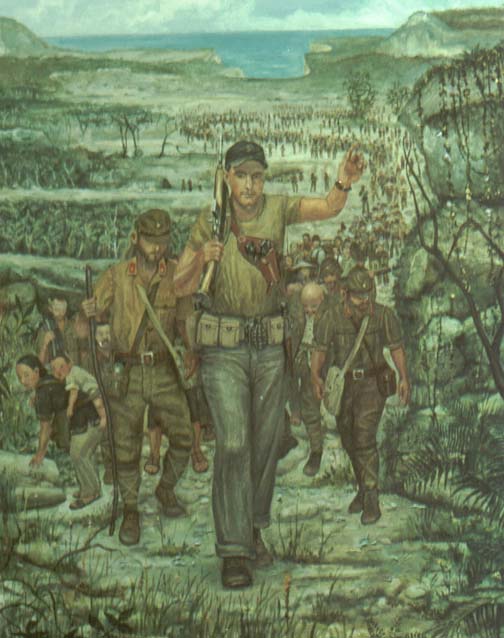
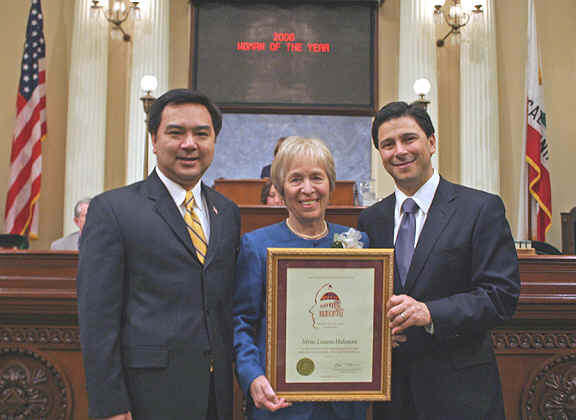

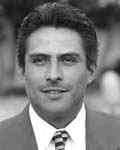
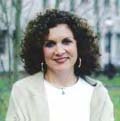 Excerpt:
Excerpt: 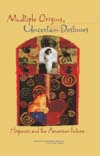
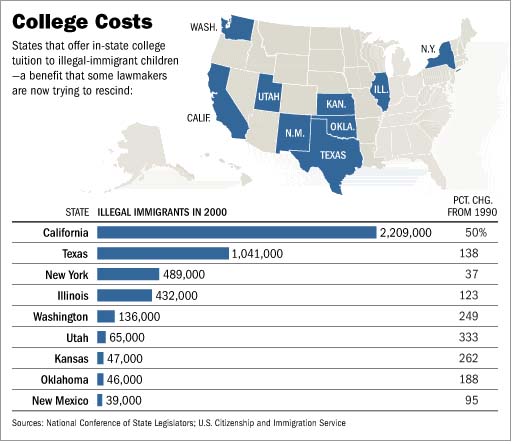
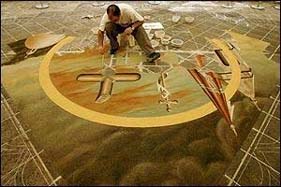
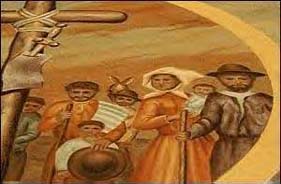
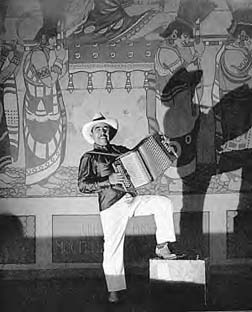
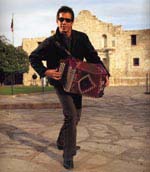

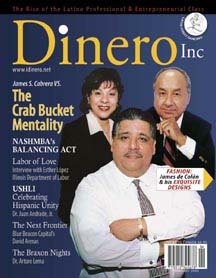
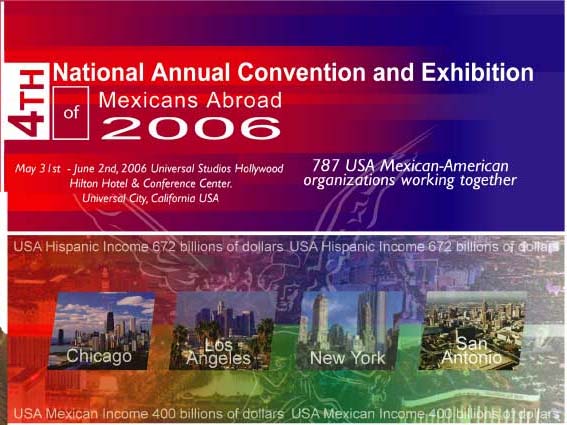
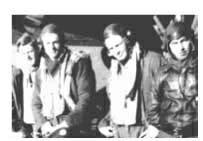
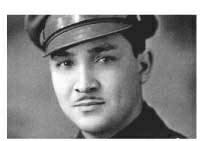
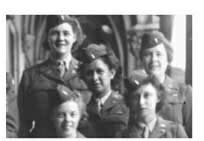

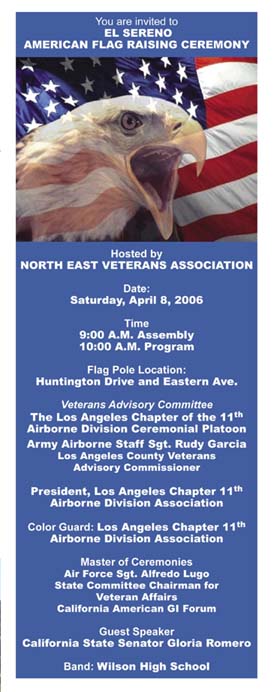

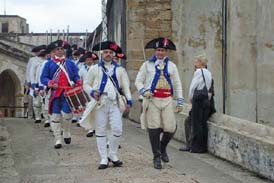
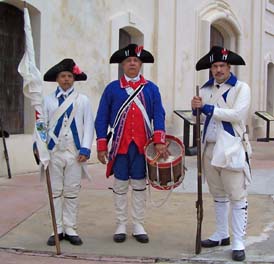
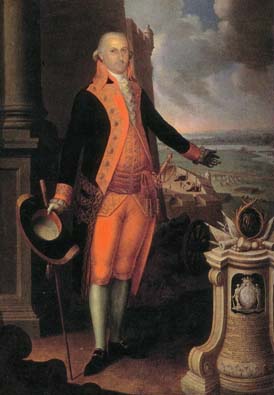
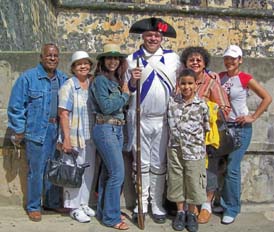

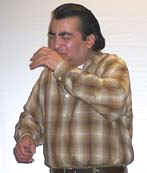
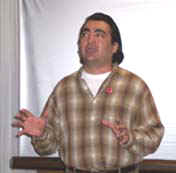
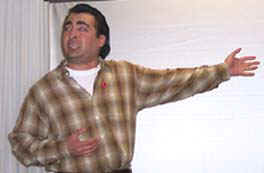
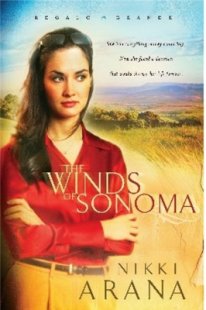 Angelica
Amante at twenty-four must make a career-ending moral decision when the
high profile, New York law firm she works for demands that she use her
brilliant legal talent to protect the wealthy by exploiting the poorest of
the poor.
Angelica
Amante at twenty-four must make a career-ending moral decision when the
high profile, New York law firm she works for demands that she use her
brilliant legal talent to protect the wealthy by exploiting the poorest of
the poor.
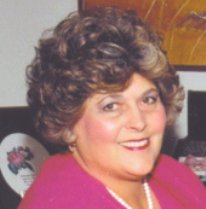
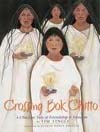
 Cossing Bok Chitto is a tribute to the Indians of every nation who aided the runaway people of bondage."
Tim Tingle is an enrolled member of the Choctaw Nation of Oklahoma. His great-great grandfather, John Carnes, walked the Trail
Cossing Bok Chitto is a tribute to the Indians of every nation who aided the runaway people of bondage."
Tim Tingle is an enrolled member of the Choctaw Nation of Oklahoma. His great-great grandfather, John Carnes, walked the Trail 
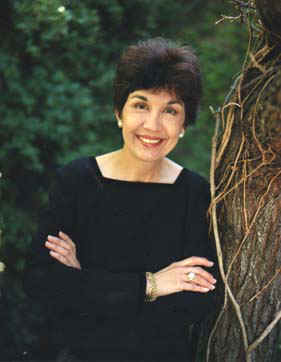
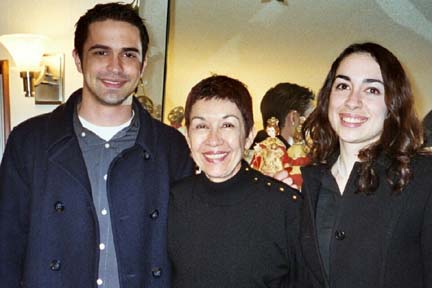
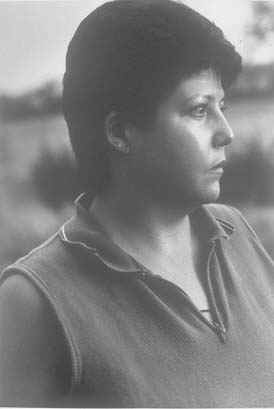
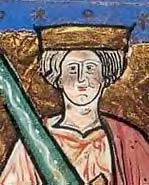 Among
them are Aethelred II, Saxon King of England, Afonso Enriques, First King
of Portugal, Bela I, King of Hungary, Boleslaw I "The Brave,"
King of Poland. Also, Emperor Charlemagne, King of the Franks, Charles
Martel, "The Hammer," King of the Franks, Conrad II, King of
Germany and Holy Roman Emperor, Duncan I, King of Scotland, and Eleanor of
Aquitaine (sister of Richard the Lionhearted).
Among
them are Aethelred II, Saxon King of England, Afonso Enriques, First King
of Portugal, Bela I, King of Hungary, Boleslaw I "The Brave,"
King of Poland. Also, Emperor Charlemagne, King of the Franks, Charles
Martel, "The Hammer," King of the Franks, Conrad II, King of
Germany and Holy Roman Emperor, Duncan I, King of Scotland, and Eleanor of
Aquitaine (sister of Richard the Lionhearted).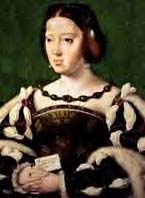
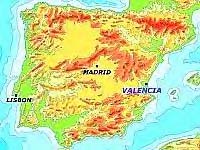 The
roots of Hispanic origins are traced to the early Iberian tribes of the
peninsula (whose origins are obscure). They later fused their blood with
subsequent conquerors such as the Celts, Phoenicians, Romans, Greeks,
Visigoths and Moors.
The
roots of Hispanic origins are traced to the early Iberian tribes of the
peninsula (whose origins are obscure). They later fused their blood with
subsequent conquerors such as the Celts, Phoenicians, Romans, Greeks,
Visigoths and Moors.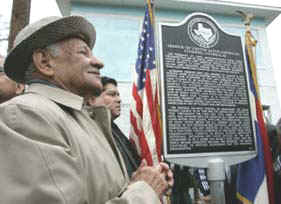
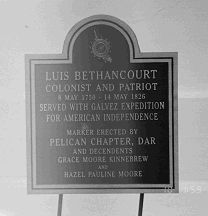
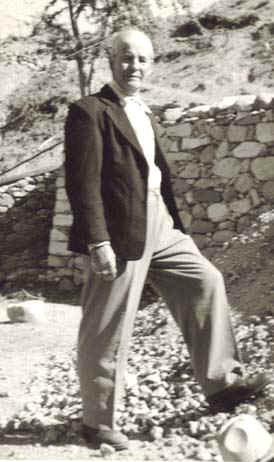
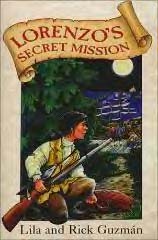
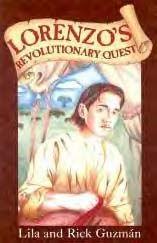
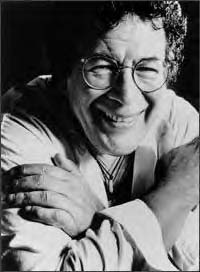 Ray Barretto Passed Away, Fri Feb 17, 2006
Ray Barretto Passed Away, Fri Feb 17, 2006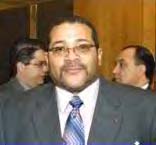
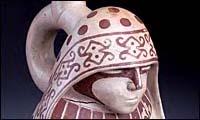 New
exhibit: Divine and Human: Women in Ancient Mexico and Peru,
which through art examines the roles of women in pre-Columbian society.
Founded in 1981, the National Museum of Women in the
Artas is dedicated exclusively to the exhibition, preservation, and
acquisition of works by women artists of all nationalities and
periods.
New
exhibit: Divine and Human: Women in Ancient Mexico and Peru,
which through art examines the roles of women in pre-Columbian society.
Founded in 1981, the National Museum of Women in the
Artas is dedicated exclusively to the exhibition, preservation, and
acquisition of works by women artists of all nationalities and
periods. 
